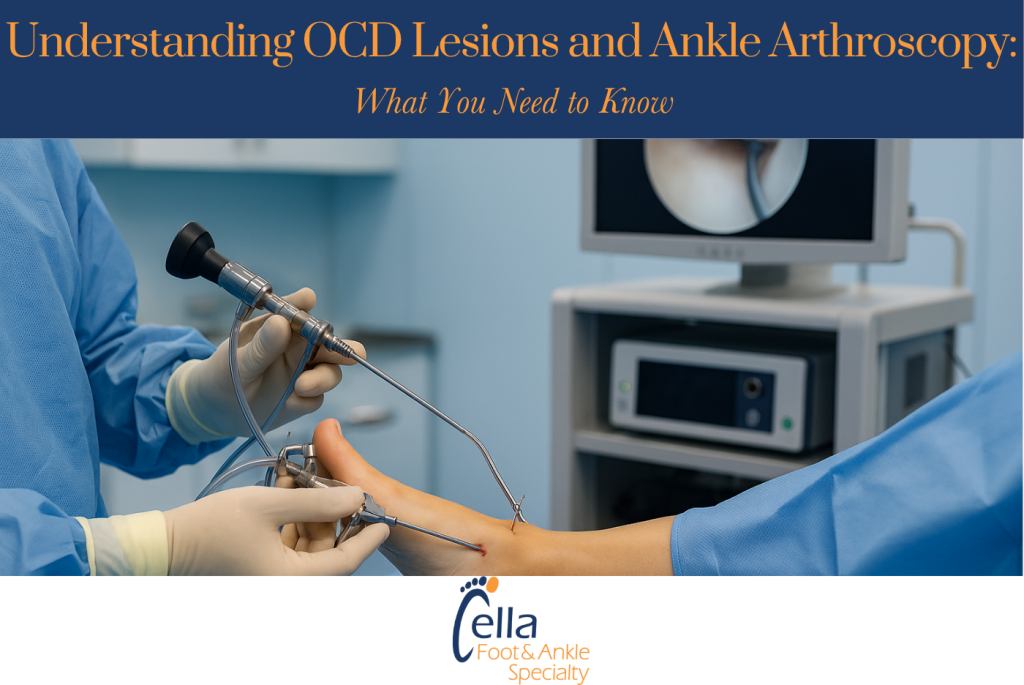
Ankle pain can affect anyone — from athletes to individuals who simply twist their ankle the wrong way. One of the lesser-known yet significant causes of persistent ankle pain is an Osteochondral Defect (OCD) lesion, a condition that damages the cartilage and underlying bone in the ankle joint. At Cella Foot & Ankle Specialty, Dr. Antonella Cella, DPM, specializes in diagnosing and treating these complex conditions using advanced techniques such as ankle arthroscopy — a minimally invasive procedure that promotes faster recovery and better outcomes.
What Are OCD Lesions?
An Osteochondral Defect (OCD), also called an osteochondral lesion, occurs when the cartilage and bone of the ankle joint (most often the talus bone) become damaged. This can result from a traumatic ankle injury, such as a severe sprain, or from repetitive microtrauma over time. In some cases, the bone beneath the cartilage may lose its blood supply, leading to collapse or detachment of the cartilage surface.
Common symptoms include:
- Chronic ankle pain or tenderness
- Swelling after activity
- Catching, locking, or instability in the ankle
- Limited range of motion
If left untreated, OCD lesions can lead to arthritis and long-term joint degeneration.
What Is Ankle Arthroscopy?
Ankle arthroscopy is a minimally invasive surgical technique used to diagnose and treat conditions within the ankle joint. Using small incisions, a thin camera (arthroscope) and specialized instruments are inserted to visualize and repair the damaged tissue. This approach minimizes disruption to surrounding tissues compared to open surgery, allowing for faster recovery and less postoperative pain.
Conditions commonly treated with ankle arthroscopy include:
- OCD lesions (osteochondral defects)
- Loose bone or cartilage fragments
- Impingement syndromes
- Synovitis or inflammation
- Scar tissue buildup
- Ankle instability
The Arthroscopic Treatment of OCD Lesions
When treating OCD lesions arthroscopically, Dr. Cella may use several techniques depending on the size and severity of the lesion:
- Debridement: Removing loose fragments and smoothing the damaged area.
- Microfracture: Creating small holes in the bone to stimulate new cartilage growth.
- Fixation: Securing detached bone or cartilage fragments.
- Grafting or cartilage transplantation: Replacing severely damaged cartilage with healthy tissue.
These methods help restore smooth joint movement, reduce pain, and prevent further degeneration.
Recovery After Ankle Arthroscopy
Recovery time varies depending on the extent of the lesion and the type of procedure performed. In general:
- Patients often use crutches for the first few weeks to keep weight off the ankle.
- Physical therapy begins early to restore motion and strength.
- Most patients return to normal activities within 6–12 weeks, although full sports participation may take longer.
Dr. Cella and her team provide a personalized recovery plan to ensure safe and successful rehabilitation.
Why Choose Cella Foot & Ankle Specialty?
At Cella Foot & Ankle Specialty, Dr. Antonella Cella combines advanced diagnostic imaging, minimally invasive arthroscopic techniques, and a patient-centered approach to achieve optimal outcomes. Her expertise in foot and ankle surgery allows her to tailor treatment to each patient’s needs — helping you get back to pain-free movement with confidence.
Frequently Asked Questions (Q&A)
Q: How do I know if I have an OCD lesion in my ankle?
A: Persistent ankle pain, swelling, or locking that does not improve with rest may indicate an OCD lesion. Dr. Cella can confirm the diagnosis using advanced imaging such as MRI or CT scans.
Q: Is ankle arthroscopy painful?
A: The procedure is performed under anesthesia, so patients feel no pain during surgery. Post-operative discomfort is typically mild and well-controlled with medication and rest.
Q: How long is the downtime after arthroscopy?
A: Most patients can bear weight within a few weeks, depending on the extent of the repair. Dr. Cella provides individualized recovery timelines.
Q: Will ankle arthroscopy leave a scar?
A: Because the incisions are small (typically less than a centimeter), scarring is minimal compared to traditional open surgery.
Q: Can arthroscopy prevent ankle arthritis?
A: Early treatment of OCD lesions and other intra-articular issues can help preserve joint function and reduce the risk of developing arthritis later.
Q: What can I expect at my consultation?
A: Dr. Cella will review your symptoms, perform a thorough physical exam, and order diagnostic imaging. Together, you’ll discuss treatment options that best suit your condition and lifestyle.
Contact Cella Foot & Ankle Specialty
Cella Foot & Ankle Specialty
19–21 Fair Lawn Avenue, Suite 2A
Fair Lawn, NJ 07410
📞 Phone: (201) 773-6557
🌐 Website: cellafas.com
🗓️ Book an Appointment: Schedule with Dr. Antonella Cella, DPM
